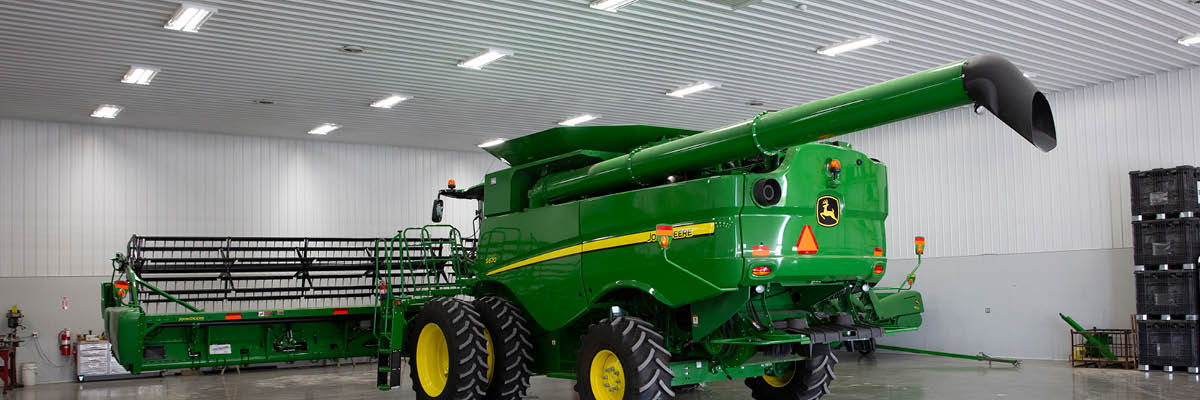Posts | Building Features | Energy Efficiency
Pole Barn Insulation: 4 Ways to Defend Your Building From Heat Loss
Cori grew up on her family's small grain and livestock operation in Northwest Indiana. In 2018, she graduated Summa Cum Laude with a Bachelor's degree in Business Administration & Marketing from Marian University Indianapolis. Having shown beef cattle for 12 years at the county, state, and national levels, Cori chose to pursue a career in agriculture. Today, she serves as the Marketing Content Creator on the FBi team. In her free time, Cori enjoys spending time with family and friends, watching sports, listening to live music, and traveling.
Brace yourself; winter is officially among us.
As Midwesterners, we know firsthand that Mother Nature can be unpredictable. We never know what type of winter she’ll bless us with until it’s here.
One day, it’s sunny with clear skies. The next, we’re shoveling our snowy driveways and skating across the parking lot.
Sure, the meteorologists watch the radar and share their predictions. The Old Farmer’s Almanac compares solar patterns and historical weather conditions with current solar activity. However, these methodologies aren’t 100% accurate.
Some people dread the long winter months. Meanwhile, others find serenity in the white snow.
Whatever your preference, we’re bound to agree on one thing. We don’t enjoy paying the increased energy rates when the cold weather strikes.
In your house, you take inexpensive precautions to combat the brutal chill, such as:
- Sealing drafty doorways
- Closing off unused rooms
- Hanging up thicker curtains
- Covering bare floorboards with a rug
- Adding protective layers over the windows
- Relying on other heat sources so your furnace can catch a break
Comfort is key in your living quarters. But what preventative measures do you take to keep your pole barn at a reasonable climate?
After all, you spend most of your time in the farm shop or man cave. It only makes sense to take similar safeguards.
In post-frame construction, insulation is the primary defense against heat loss through the building envelope.
Upfront costs may seem daunting, but insulating your post-frame building is an investment on its own. Your monthly operating costs will decrease considerably based on the insulation’s R-value.
Below, we discuss the importance of R-Value and the four types of insulation you should consider installing in your pole barn.
Let us help you lower heat conduction, maximize comfort, and minimize fuel bills.
What is an R-Value in Pole Barn Insulation?
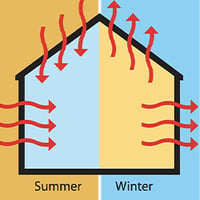 A rating known as an R-value measures an insulating material’s resistance to heat flow (or conduction). The higher the R-value, the higher the resistance to heat loss.
A rating known as an R-value measures an insulating material’s resistance to heat flow (or conduction). The higher the R-value, the higher the resistance to heat loss.
Moreover, the amount of R-value your pole barn will need depends on the following factors:
- Climate zone
- Type of HVAC system installed
- Area size needing an extra layer of defense
Although it’s a useful measure, R-value is only one way of gauging the effectiveness of insulation. Air infiltration must be taken into account.
For example, an airy post-frame building with a high R-value may be colder in the winter than an airtight structure with a low R-value. Therefore, the entire “system” must be considered.
Please remember that the overall R-value of a wall or ceiling may differ from the insulation itself. Sometimes, heat will flow around the insulation, going through or around laminated posts and joists.
Working with a post-frame builder will ensure proper installation, thus achieving the maximum R-value.
4 Insulation Solutions for Your Pole Barn
Now that you understand the importance of R-value, we’ll dive deep into the different insulating materials for your pole barn.
As you consider the options, ask yourself the following questions:
- Will the post-frame building be heated?
- If so, how warm will the structure be?
- Will it be temporarily or permanently heated?
- When you look up, do you see trusses or a finished ceiling?
Your answers will guide you through the decision-making process.
1) Perimeter Slab Insulation
If you walk out to your garage, there’s a good chance it has a concrete floor sitting on top of the ground.
Furthermore, the ground has its own R-value. If you insulate around the perimeter, you can protect that R-value and prevent heat from escaping around the building.
Typically, a thick 2-inch piece of rigid board insulation is vertically installed alongside the columns or horizontally under the floor.
Does your pole barn have in-floor heating? Maybe it sits over a high water table? If so, you’ll want to insulate under the entire floor. Otherwise, the water will steal the heat as it flows away from the structure.
2) Wall Insulation
Next, the walls of your post-frame building act as barriers from adverse weather conditions.
Without wall insulation, conduction will occur regardless of the heating-cooling system employed. In other words, you’re throwing your hard-earned money down the drain.
For instance, heat will exit your tool shed even if the furnace runs full steam ahead. Therefore, adding wall insulation will greatly reduce heat conduction.
There are five types of wall insulation used in pole buildings:
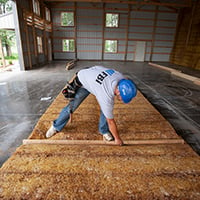 Fiberglass Batts
Fiberglass Batts
First, fiberglass batts are the most common type of insulation used in the walls of post-frame structures. It’s well-known for its relatively low cost and ease of installation.
Long spans of fiberglass insulation can be placed in between posts, resulting in few breaks (or air leaks) among batts.
If you opt for fiberglass batts, you’ll want to look into a vapor barrier. It’s an impermeable membrane placed in the middle of insulation and interior walls.
Vapor barriers minimize condensation caused by moisture buildup within the envelope.
This blockade prevents insulation from getting wet, which lessens its performance and causes deterioration.
Vinyl Back
On the other hand, the vinyl back is a fiberglass batt with a white coating on the backside.
Usually, it’s fitted in between the framing. But this arrangement can cause issues with sagging.
Vinyl back is a thinner insulation than fiberglass batts (lower R-value).
Not to mention, it can be a challenge to situate properly. The R-value varies by thickness.
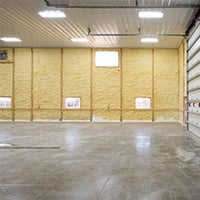 Sprayed Polyurethane Foam (SPF)
Sprayed Polyurethane Foam (SPF)
In recent years, sprayed polyurethane foam (SPF) has become a popular but expensive alternative to fiberglass batts.
SPF fills and seals all exposed areas and cracks within the pole barn, giving you greater protection from air drafts and moisture.
Due to the chemicals and equipment involved, a professional spray-foam contractor should be hired to do the job.
If part of your wall needs to be replaced at any given point, this glue-like material can be difficult to remove.
On top of that, some spray foam products haven’t been tested or approved for steel use.
Consequently, some metal suppliers won’t provide warranty coverage if SPF is used. Check with your professional builder before making a final decision.
Rigid Board Insulation
These rigid panels are installed directly underneath the steel siding and provide continuous coverage with a very high R-value (less air infiltration).
Most importantly, not all rigid board products are created equal. Please make sure it’s approved for use in exposed applications.
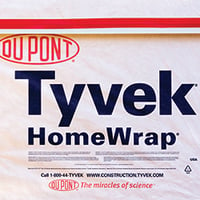 Building Wrap
Building Wrap
Although it isn’t considered insulation, building wrap is an optional convection barrier.
Similar to rigid boards, building wrap is installed underneath the siding of your pole barn.
Also, building wrap is an additional air infiltration and moisture blockade. It works with your insulation to keep the interior comfortable.
Before purchasing, please consider building codes, steel strength, and type of insulation to determine if building wrap is a wise investment.
For local construction codes, please get in touch with your local building official or authority having jurisdiction (AHJ).
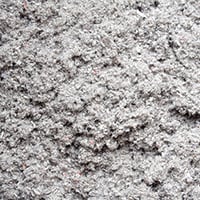 3) Attic Insulation
3) Attic Insulation
Attic insulation requires a drywall or steel ceiling. Once finished, the most common applications are fiberglass batts and blown insulation.
When blown insulation is installed correctly, the loose fill provides an airtight finish between the ceiling joists and bottom chords of the trusses.
A contractor with specialized equipment applies blown insulation. It’s easy to insert (no cutting or fitting involved), can adapt to any R-value, and conforms to odd-shaped spaces.
According to Energy-Star, the recommended level is R-38 (10 to 14 inches) for attics.
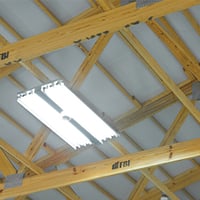 4) Roof Insulation
4) Roof Insulation
Lastly, an insulated roof is an inexpensive alternative to an interior liner package. Typically, it’s installed under the roof sheathing with exposed truss members.
This insulating material works well with radiant heat as opposed to forced air. With the latter, much of the heat rises into the truss space.
Rigid board insulation, such as Thermax®, is a common roof application. It prevents the need for interior finishes (e.g., drywall).
In addition, a radiant barrier (the combination of batts and spray foam) resists heat flow by absorbing and slowing the heat transfer.
Radiant barriers can be placed virtually anywhere in your building. But it works better in attics or under roofs of air-conditioned structures.
Keep in mind that a radiant barrier only functions when at least one side is facing an air space.
Which Type of Insulation is Right for You?
At the end of the day, how you choose to insulate your pole barn is up to you. As one of the top post-frame builders in the Midwest, we aim to recommend top heating solutions to help you get the most out of your space.
The price may seem intimidating. But remember, you only need to insulate climate-controlled parts of the structure. Well-insulated spaces will lower heat conduction, maximize comfort, and minimize fuel bills.
For more information, you can download our FREE “Ultimate Guide to Pole Barn Insulation." With our expertise, you’ll discover how to reduce utility costs and enjoy money-saving benefits.
Do you have more questions about pole barn insulation that are not covered in this article? Please contact FBi Buildings at 1.800.552.2981 or click here to email us. If you are ready to get a price, click here to request a quote, and a member of our sales team will give you a call.
